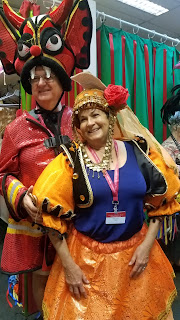This is summer and high season in Brazil. Many cruise ships come, adding even more crowds. Danna knew well enough to get us out early before both the heat and the crowds became unmanageable. Our first stop was the iconic Christ the Redeemer statue. We took a train up the mountain where the statue is.
It's like Denali, you never know if you will get a good view. The clouds sometimes obscure the statue. Danna told us we needed patience, and our patience paid off. It actually gave me goosebumps to look up at that statue. I've seen it in so many pictures and television shots, I had to pinch myself to believe I was actually there looking up at it. It was very special.
"The colossal statue of Jesus Christ at the summit of Mount Corcovado, Rio de Janeiro, southeastern Brazil. It was completed in 1931 and stands 98 feet (30 metres) tall, its horizontally outstretched arms spanning 92 feet (28 metres). The statue, made of reinforced concrete clad in a mosaic of thousands of triangular soapstone." (Wikipedia)
Mel took this shot of it at night from the roof of our hotel
Next up: " Escadaria Selarón, also known as the 'Selaron Steps', is a set of world-famous steps in Rio de Janeiro, Brazil. They are the work of Chilean-born artist Jorge Selarón who claimed it as "my tribute to the Brazilian people".
"There are 215 steps measuring 125 metres long which are covered in over 2000 tiles collected from over 60 countries around the world." (Wikipedia)
Our next adventure involved us getting on motorbikes and riding up to the top of a winding hill for lunch in the historic St. Teresa District.
This is Terri's photo of Mel getting on his motorbike (I was busy getting on mine!)
Later, we drove along the iconic Ipanema Beach. Mel shot interesting sand castles there.
Dinner that night was at a local restaurant known for its rotisserie chicken. It was tasty and came with lively entertainment, the cook who grilled on a coal-fired grill.

 This is the balcony of the building where Eva Peron is said to have addressed the people of Argentina.
This is the balcony of the building where Eva Peron is said to have addressed the people of Argentina.



































